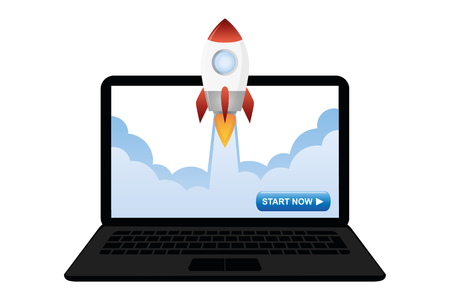1. Understanding Bootstrapping: The American Dream in Action
Bootstrapping is a term you’ll hear a lot in the world of startups, especially in America. At its core, bootstrapping means building your business from the ground up with little or no outside funding—just using your own money, resources, and hustle. This approach isn’t just about saving money; it’s about taking control of your vision, making smart decisions with what you have, and learning how to do more with less.
What Does “Bootstrapping” Really Mean?
The term comes from the old saying “pull yourself up by your bootstraps.” In entrepreneurship, it’s all about starting something new without relying on big investors or banks. Instead of pitching venture capitalists or applying for loans, founders use their savings, income from early sales, or even side gigs to fund their dreams.
Why Bootstrapping Fits the American Entrepreneurial Spirit
America has always celebrated self-made success stories. From garage startups in Silicon Valley to small-town shops that grow into national chains, many of the most inspiring business journeys started with bootstrapping. It matches the American values of independence, resilience, and hard work.
Roots of Bootstrapping in U.S. Culture
| Era | Bootstrapping Examples | Cultural Influence |
|---|---|---|
| Colonial Times | Small farms and family-owned shops | Pioneering spirit and self-reliance |
| Early 20th Century | Main Street businesses, mom-and-pop stores | The American Dream—anyone can make it with hard work |
| Modern Day | Tech startups in garages or home offices | Innovation and “disruption” from humble beginnings |
Why Do Entrepreneurs Choose Bootstrapping Over Traditional Funding?
There are lots of reasons why founders choose to bootstrap their companies instead of chasing outside money:
| Reason | Description | American Example |
|---|---|---|
| Control & Independence | No investors telling you what to do or demanding fast returns. | Sara Blakely built Spanx her way without giving up control. |
| Learning & Growth | You learn every part of the business because you’re hands-on. | Dell Computers started with Michael Dell building PCs in his dorm room. |
| Resourcefulness | You get creative and find smart solutions when funds are tight. | GoPro founder Nick Woodman sold bead belts out of his van to fund his first camera prototype. |
| No Debt or Equity Loss | You don’t owe anyone money or give up shares in your company. | Mailchimp grew without outside investors—and stayed 100% founder-owned until its acquisition. |
| Pride in Building Something Yourself | The sense of accomplishment is huge when you make it on your own terms. | CertainTeed Insulation started as a tiny operation and became an industry leader through gradual growth. |
The Bottom Line: Bootstrapping Is Alive and Well in America
This path isn’t easy—but it’s real, authentic, and deeply woven into the story of American entrepreneurship. In this series, we’ll dive into stories from real founders who made it happen through bootstrapping, showing what’s possible when you bet on yourself and get creative with limited resources.
2. Grit and Grind: Challenges Faced by U.S. Bootstrapped Entrepreneurs
Financial Constraints: Stretching Every Dollar
One of the biggest hurdles for bootstrapped entrepreneurs in America is managing money. When you’re funding your business from your own pocket, every expense matters. Many founders juggle credit cards, personal savings, and even side gigs to keep their dreams alive.
| Challenge | Real-Life Example |
|---|---|
| Limited Cash Flow | Sarah, who started a home-based bakery in Texas, relied on pre-orders and used her kitchen to avoid renting space. |
| No Outside Investment | Mike launched a software tool in Chicago using his severance pay after a layoff, skipping paid ads and focusing on word-of-mouth marketing. |
Resource Limitations: Wearing All the Hats
Without big budgets or a large team, self-funded founders often do everything themselves—from sales and marketing to customer service and shipping. It’s not unusual for American entrepreneurs to learn new skills on YouTube or call in favors from friends and family just to get things done.
| Area | Bootstrapping Solution | Example Story |
|---|---|---|
| Marketing | DIY social media posts instead of hiring an agency | Tony in Florida filmed product demos on his iPhone and shared them on Instagram to build buzz for his surf gear brand. |
| Operations | Personal delivery or fulfillment to save costs | Lena drove her handmade candles to local shops in Seattle herself instead of paying for shipping services. |
Work-Life Balance: The Never-Ending Hustle
For many American bootstrappers, finding time for family, friends, or even rest can feel impossible. There’s no nine-to-five when you’re building a business from scratch—just long days and late nights fueled by coffee and determination.
The Balancing Act: Common Trade-Offs for U.S. Founders
| Work-Life Challenge | How Founders Cope | True Story |
|---|---|---|
| Missing Family Time | Scheduling “no work” hours during dinner or weekends | Megan in Colorado set strict family movie nights to make sure she didn’t miss out on time with her kids while growing her pet supply store. |
| Battling Burnout | Taking micro-breaks or short walks during the day instead of full vacations | Carlos in New York took daily walks around Central Park between phone calls to clear his head while launching his consulting business. |
The American Spirit: Pushing Through Together
No matter where they start or what industry they’re in, American bootstrapped entrepreneurs share a common thread—resilience. They tackle these everyday struggles with creativity, community support, and an unshakable belief that hard work can turn big dreams into real businesses.

3. Resourcefulness Redefined: Creative Solutions and Hustle
Bootstrapping in America isn’t just about pinching pennies—it’s about making every dollar count by thinking outside the box. American entrepreneurs have a reputation for their hustle and ingenuity, often turning limited resources into big opportunities through creative strategies. Here’s how self-funded founders across the country are redefining resourcefulness to fuel their startups:
Side Hustles: Funding the Dream One Gig at a Time
Many founders keep their startup dreams alive by juggling side hustles. Whether it’s freelancing, consulting, driving for ride-share apps, or selling handmade goods online, these gigs provide essential cash flow without diluting ownership or taking on debt. Side hustles not only help pay the bills but also expand skillsets and networks.
Popular Side Hustles Among American Entrepreneurs
| Type of Side Hustle | Benefits | Real-World Example |
|---|---|---|
| Freelance Digital Work (design, writing, coding) | Flexible hours, builds relevant skills | A founder freelances on Upwork to fund product development |
| Rideshare Driving (Uber, Lyft) | Immediate income, networking with locals | An entrepreneur drives evenings to cover rent while launching a food startup |
| E-commerce Sales (Etsy, eBay) | Monetizes hobbies, tests business ideas | A craft lover sells custom T-shirts online while growing her main brand |
Bartering: Trading Skills Instead of Dollars
When cash is tight, many bootstrappers swap services instead of spending money. Need a website but can’t afford a developer? Offer to manage their social media in return. This old-school method still thrives in co-working spaces and local business communities across the U.S.
Bartering Success Stories:
- A tech startup trades IT support for free office space at a local coworking hub.
- A marketing pro helps a photographer with branding in exchange for professional headshots.
- A baker supplies treats for a design firm’s events and receives free logo design.
Leveraging Personal Networks: The Power of Connections
American entrepreneurs know that who you know can be just as important as what you know. By tapping into personal and professional networks—friends, family, former colleagues—founders access advice, introductions, and sometimes even their first customers or team members without spending a dime.
- MVP Feedback: Friends test early product versions and offer honest feedback.
- No-Cost Marketing: Family shares new business launches on social media to generate buzz.
- Sweat Equity: Old college friends pitch in with legal work or accounting help in exchange for future favors or small equity stakes.
This scrappy approach is woven into America’s entrepreneurial fabric, proving that creativity and hustle can stretch every dollar further than most people think.
4. Lessons Learned: Wisdom from Those Who’ve Walked the Walk
Perseverance Pays Off
Ask any self-funded entrepreneur in America, and you’ll hear the same thing: grit matters more than anything. Bootstrappers like Sarah, who launched her Texas-based apparel brand from her garage, emphasize that there are no overnight successes. She worked two part-time jobs while building her business late into the night. The big takeaway? Keep pushing, even when progress feels slow. Staying consistent—even if it’s just one small step every day—makes all the difference.
How to Handle Failure Like a Pro
Failure isn’t just common; it’s expected. Mike, who started a New York tech consultancy with his savings, shared that his first three product launches flopped. Instead of giving up, he treated each setback as free education. His advice is simple: when something fails, write down what went wrong, adjust your approach, and move forward without beating yourself up. Here’s how real founders turn failures into growth:
| Challenge | What They Did | Lesson Learned |
|---|---|---|
| Product flop | Pulled customer feedback, changed design | Listen to your market |
| Cash crunch | Cut expenses, renegotiated contracts | Every dollar counts |
| No initial sales | Tried different marketing channels | Pivot quickly and test often |
Making Tough Calls Without a Safety Net
Bootstrapping means making hard decisions—often alone. Dana, who runs a small digital agency in Chicago, once had to choose between hiring her first employee or upgrading equipment. She weighed the pros and cons by asking herself which would get her closer to paying clients faster. Her tip for other founders: when you don’t have backup funding, focus on choices that directly impact revenue or customer satisfaction first.
Actionable Advice from Real Entrepreneurs
- Track Every Penny: Use simple spreadsheets or apps to know exactly where your money goes.
- Lean on Your Network: Don’t be shy about reaching out for advice or introductions—most people are happy to help.
- Pace Yourself: Burnout is real; schedule breaks and downtime so you don’t fizzle out early.
- Stay Resourceful: Reuse, recycle, barter—find creative ways to get what you need without spending much.
- Celebrate Small Wins: Every sale or happy customer is progress worth acknowledging.
The American Bootstrapper Mindset
If there’s one thing these stories show, it’s that American bootstrappers thrive on hustle and heart. They turn obstacles into stepping stones and keep their eyes on the bigger picture—even when it’s tough. Their wisdom? Keep learning, stay flexible, and never lose sight of why you started in the first place.
5. Looking Ahead: The Evolving Landscape of Bootstrapping in the U.S.
Today, bootstrapping is no longer just about scrimping and saving every penny. With the rapid development of technology, a supportive online community, and new business models, American entrepreneurs are finding creative ways to launch and grow their businesses with limited resources. Let’s explore some of the major trends and tools shaping the next wave of bootstrapped success stories.
New Trends in Bootstrapping
Modern self-funded founders are rethinking how to start and scale. Here are some key shifts:
| Trend | How It’s Changing Bootstrapping |
|---|---|
| Remote-First Businesses | Entrepreneurs can hire global talent, cut office costs, and operate virtually from day one. |
| No-Code & Low-Code Tools | Building apps and websites is faster and cheaper—no need for a big tech team. |
| Subscription Models | Monthly recurring revenue helps founders predict cash flow and reinvest profits steadily. |
| Community-Led Growth | Founders use social media, online groups, and local meetups to build loyal customer bases without expensive ads. |
| E-commerce Platforms | User-friendly tools like Shopify and Etsy let anyone set up shop with minimal upfront costs. |
The Power of Technology for Self-Funded Startups
The right technology stack can level the playing field for solo founders and small teams. Here are some favorite tools among American bootstrappers:
| Category | Popular Tools/Platforms | Main Benefit |
|---|---|---|
| Email Marketing | Mailchimp, ConvertKit | Affordable ways to reach customers directly with updates and promotions. |
| No-Code App Builders | Bubble, Webflow, Glide | Create web or mobile apps without coding skills—just drag and drop. |
| E-commerce Solutions | Shopify, WooCommerce, Etsy | Quick setup for selling products online, managing inventory, and handling payments. |
| Collaboration & Productivity | Trello, Slack, Notion | Keep remote teams organized and projects on track at little to no cost. |
| Payment Processing | Stripe, PayPal, Square | Smoothly accept payments from customers anywhere in the world. |
The Changing Market Environment for Bootstrappers in America
The U.S. market has become both more competitive and more open to innovative ideas from resourceful entrepreneurs. Here’s what’s different today:
- Diverse Funding Alternatives: Crowdfunding platforms like Kickstarter let founders raise money directly from future customers instead of traditional investors.
- Niche Markets Thrive: Targeting smaller audiences can be profitable thanks to targeted online marketing and tailored product offerings.
- Cultural Shift Toward Small Business: Americans increasingly value supporting local makers and indie brands over big corporations.
The Next Generation of Self-Funded Entrepreneurs: What Sets Them Apart?
- A DIY Mindset: Willingness to learn new skills—from design to digital marketing—without hiring expensive agencies.
- A Focus on Sustainability: Building businesses that last by reinvesting profits instead of chasing fast growth at all costs.
- An Emphasis on Authenticity: Telling real stories behind their brands builds trust with modern consumers who want to know who they’re buying from.
Summary Table: The New Bootstrapping Playbook in America
| Pillar | Description/Example |
|---|---|
| Lean Operations | No fancy offices—just laptops at home or shared workspaces like WeWork. |
| Online Communities & Networks | Makers share advice on Indie Hackers, Reddit, or via Twitter threads. |
| Selling Direct-to-Consumer (DTC) | Avoiding middlemen boosts profit margins; think craft coffee roasters or custom T-shirt brands selling online. |
The landscape for bootstrapping in America keeps evolving. With the right mix of grit, creativity, and smart tech choices, tomorrow’s entrepreneurs have more opportunities than ever to turn small ideas into lasting businesses—all on their own terms.


